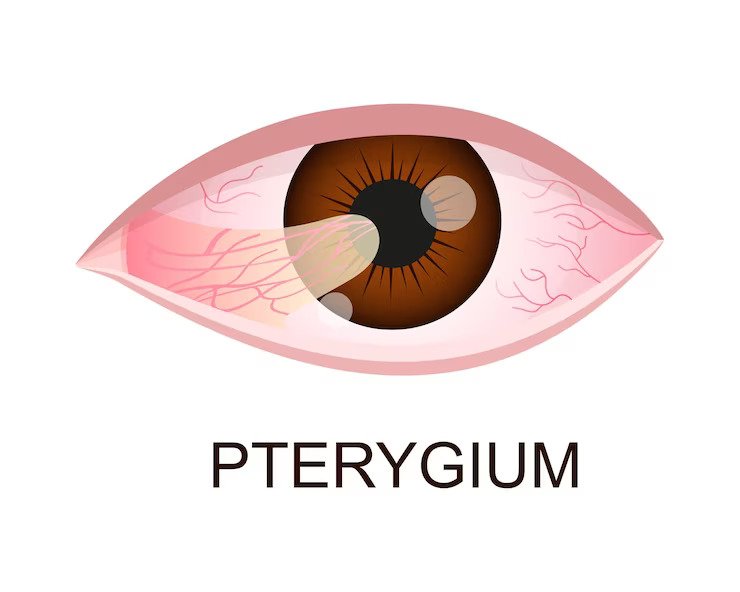Do you feel sand or grit in your eyes with redness and itchiness? Beware! It may indicate pterygium. This is an eye condition, commonly called ‘surfer’s eye,’ in which you see a fleshy overgrowth on your eyes’ conjunctive. It is a transparent mucous membrane that covers the sclera (white part of your eyes) and the inside of your eyelid.
If pterygium fully grows across the cornea of your eyes, it may block your vision. Usually, it affects one or both eyes but at different times. When it impacts both of your eyes at the same time, it is called bilateral pterygium.
To keep your vision safe, you must know about its causes, risk factors, diagnosis, and treatment options. Read on.
What is the Reason for Developing Pterygium?
Since overgrowth of conjunctiva tissue causes pterygium, the following may be the associated reasons:
- Prolonged exposure to ultraviolet rays (UV)
- Eye irritation due to working in dry and windy areas
In this eye condition, some common signs are mild eye pain, raised pink and fleshy growth in eyes, teary eyes, and blurred or double vision. When you observe any of these, it is a clear indication to visit a doctor for treatment.
How Do Doctors Diagnose Pterygium?
Pterygium reflects obvious symptoms, and here are the tests that eye care professionals proceed with:
- Slit Lamp Examination
Slit Lamp examination is a common eye test to analyse the condition of your eyes. Your eye care specialists use a slit lamp (a type of microscope with a bright light) to inspect your eye’s front and inside parts.
- Corneal Topography
Corneal topography is an exam done to measure changes in your cornea curvature and create a 3D map of its surface.
- Visual Acuity Test
Eye care professionals conduct a visual acuity test to understand your vision ability. They allow you to read letters on an eye chart at a certain distance.
- Photo Documentation
Your eye doctors perform photo documentation to follow pterygium growth in your eyes at different intervals.
These tests allow your doctor to initiate the best treatment options in your favor.
How is Pterygium Treated?
Treatment of pterygium depends on its condition in your eyes. Its treatment options include:
- Over the Counter (OTC) Medications
Doctors may prescribe eye ointments or lubricating (wetting) drops to soothe the cornea if your eye is in discomfort. You may get steroid eye drops to ease the symptoms of severe inflammation in your eyes.
- UV Protection
When walking outdoors, your eye doctor may ask you to wear glasses for UV protection. When pterygium is not developed enough and doesn’t cause vision difficulties, UV protection helps cease its growth.
- Surgical Methods
When ointments or eye drops don’t relieve your eyes, surgery is a sure-shot way to eradicate pterygium. Removing it is crucial to avoid growth across the cornea and prevent vision loss.
What Happens During a Pterygium Surgery?
When you need to opt for surgery, you should get in touch with highly qualified eye care professionals. Below is mentioned what happens in this surgery:
- In the initial steps, you get light sedatives to numb the affected eye and avoid pain or discomfort.
- After that, eye care specialists remove pterygium from your eyes and place an amniotic membrane, which is cut in an adequate size and placed over the affected area.
- If your eye care professionals remove a particular portion of conjunctiva from under your eyelid to cover the pterygium excised opening, this is called autograft surgery. This type of surgery prevents the reappearance of this condition.
Risk and Complications of Pterygium Surgery
Pterygium surgery is a safe surgical procedure if done by the best eye care professionals. Otherwise, it may bring some of the following complications:
- Infection
- Sclera or corneal melting
- Reappearance of pterygium
- Continuous dryness or irritation
These risk factors can be treated easily, relieving your eyes from blurry vision.
Pterygium is a common condition that looks scary sometimes but is not a serious problem. You probably won’t need any treatment, but if you start observing the symptoms like tears, dryness, and raised fleshy growth, call your eye care specialists immediately.
When pterygium develops across the cornea of your eyes, it starts blocking your vision. To prevent the severity of this eye condition, you should seek medical care. With state-of-the-art facilities and great infrastructure, Dr Agarwals Eye Hospital is the best hospital to get comprehensive eye care solutions. They have a team of highly committed eye specialists devoted to offering you the best eye care treatment.
The professionals at Dr Agarwals Eye Hospital brief all the details to you and examine your eye condition, following the analysis of your medical history.
So, don’t hesitate to visit them and book your appointment immediately!






